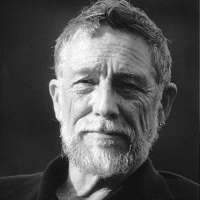Gary Snyder - Biography and Works
Gary Snyder was born in San Francisco in 1930. He was raised on a farm, and educated at Reed College. In the early 1950s he worked as a logger, forest-fire lookout, trail-crew worker, carpenter, proofreader, seaman, and teacher.

Gary Snyder (Born: 8 May 1930)
He subsequently studied Asian languages at the University of California and spent a dozen years in Japan, where he studied Zen Buddhism. His subsequent career has been a remarkable combination of the academic and the contemplative, spiritual study and physical labor. Upon his return to the States, he settled in a remote community in the Sierra Nevadas. Writing in the first person and in a plain style, working with organic meters and forms, he favors direct statement over the metaphor and allusion. Snyder has published sixteen books of poetry and prose and has received awards like National Book Award, American Book Award, and Pulitzer Prize for poetry. He now teaches literature and ‘wilderness though’ at the University of California at Davis. The shapes and strengths of Gary Snyder’s craft were established at the outset of his career.
His first book Riprap (1959) demonstrates the clarity of his seeing, his desire to crystallize moments, his striking ability to convey the physical nature. Snyder is also known as an essayist and translator of Japanese poetry, whose writing is marked by his interests in ecology, Native American myths and culture, Asian literature and philosophy, and Zen, a school of Buddhism. While at Berkeley he became friends with American writers Allen Ginsberg and Jack Kerouac, and through them he became associated with other writers of the Beat Generation. Snyder’s most enduring concerns, evident in his first collection of poems, Riprap (1959), from which the present poem is taken, have been the destructive influence of American society on the natural environment, and the possibilities for improving this relationship through people’s attitudes and actions. Snyder is influenced by both Eastern and Western spiritual traditions. Snyder is one of those Beat writers who discovered Asian literature while exploring the ideas of Zen Buddhism. Although most of them did not practice Buddhism in any strict sense, they borrowed certain Asian literary forms, including the haiku, a Japanese verse form.
Gary Snyder is a member of the “Beat Generation”. He explored a wide range of social and spiritual matters. His work blends physical reality, observations of nature – with inner insight – received primarily through the practice of Zen Buddhism. Snyder’s poems were “field of action”, “composed in the sequence of the musical phrase”, and they seemed manifestly in the spirit of “no ideas but in things”. They were also suggestible radical in outlook and orientation, informed by ecology, anthropology, and regional folklore, responsive to the gravitational pull of what would later be “Pacific Rim”, altogether aloof to the anxieties of influence afflicting so many poets of Snyder’s generation. Alone among his cohort, Snyder staked himself to a prosody of disciplined contemplative acuity and distilled perceptual awareness, a poetry of mindfulness rather than intellect, a tradition of Asian quietism and concision, a craft so well tempered and translucent that it borders on artlessness.
His publications include: The Gary Snyder Reader (1952-1998) Mountains and Rivers without End (1997); No Nature: New and Selected Poems (1993), The Practice of the Wild (1990) Turtle Island (1974), Regarding Wave (1970) Myths & Texts (1960).
Cite this Page!
Sharma, Kedar N. "Gary Snyder - Biography and Works" BachelorandMaster, 9 Nov. 2013, bachelorandmaster.com/biography/gary-snyder.html.
